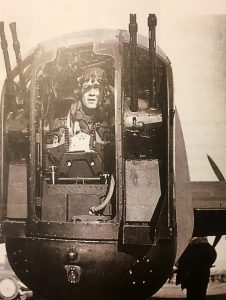
It happened kind of like choosing a partner at a high school dance, where the girls all lined up on one side of the dance floor and the boys on the other.
Only in this case, during the Second World War, the Commonwealth airmen gathered in a hangar in England – pilots in one group, navigators in another, gunners in another, etc. As RCAF gunner Ron Moyes told me the other night, bomber pilot Don Walkey first picked a navigator, Hugh Ferguson.
“Then, Fergy picked the rest of us,” said Moyes, just shy of his 97th birthday (Feb. 11). In other words, the haphazard instincts of Ferguson, a 20-year-old former miner from Manitoba (by 1944 a trained RCAF navigator) chose bomb aimer Stu Farmer from Sault Ste. Marie, Ont., radio operator Jake Redinger from Bashaw, Alta., and gunners Alvin Kuhl and Ron Moyes from Tara, Ont., and Coquitlam, B.C. respectively – all men he’d never met before – to form a bomber crew.
All six survived a full tour – 29 combat operations over Germany – and came home safely to Canada in 1945.

Last Friday, I travelled to the Canada Aviation and Space Museum in Ottawa for the screening of Above and Beyond, a documentary about the famous Lancaster bomber in WWII. The Vintage Wings museum in Gatineau, Que., sponsored the event, and asked if I would interview a Lancaster rear gunner they’d invited to the screening – Warrant Officer (Retired) Ron Moyes. I jumped at the chance.
Over many years of contact with Canadian veterans – interviewing thousands of them – I’ve almost always asked how it was they survived. Most say, fate or chance or just plain luck.
Just so you know, the odds did not favour volunteers such as Ron Moyes making it home. Between 1939 and 1945, 125,000 Allied airmen served in those nighttime raids over Europe. Of every 100 airmen in Bomber Command, 52 were killed on operations, nine were killed in accidents, 12 became prisoners of war, three were wounded, and one POW would manage to escape and make it back to England.
Of all wartime services, Bomber Command suffered the highest attrition rate – 44 per cent – meaning that 55,573 were killed, 10,500 of them being Canadian. So, how did Moyes dodge the bullet?
“We engaged in a lot of horseplay,” he told me in front of that Ottawa audience. “But on operations it was all extremely professional.”

As a rear gunner in a Lancaster, Moyes had no heat in his turret; in addition, so that he could see enemy fighters clearly at night, the Perspex (glass windshield) was also removed exposing him at 20,000 feet to an outside temperature of -40 to -60 degrees Fahrenheit. Moyes described how he dressed against the cold:
“First, I put on wool stockings up over my knees and a long turtleneck sweater. Then, my battle dress uniform and an electrically heated suit with slippers and gloves. Then, my teddy-bear suit of one-inch thick padding. Next, my Mae West life preserver, my parachute harness, flying boots, helmet, mask, goggles and three pairs of gloves.”
He couldn’t wear his parachute because the turret was too cramped, so he sat on it for the full trip (seven hours) to the target and back.
Most often, their bombing targets were weapons-production plants at Munster, Essen, Duisburg and other industrial sites along the Ruhr River, a.k.a. “Happy Valley,” deep in Germany.
On Dec. 31, 1944, Moyes’ crew was sent to drop mines at low level up the fjord leading to (Nazi-occupied) Oslo, Norway. “There was a full moon, no clouds … Stu (Farmer) dropped the mines. Then, all hell broke loose. A couple of barges were loaded with guns and (the Germans) opened up on us.
Don (Walkey) immediately put the aircraft in a dive, while we fired back. My guns were white-hot when Stu called out, ‘Skipper, pull up! I can’t swim!’ Don pulled the bomber out of the dive and we were only 75 feet above the water.”
Because it was New Year’s Eve, cooks had prepared a special meal for everybody back at RCAF 429 Squadron air base. But Ron and his crew were so exhausted when they returned, that they slept right through the turkey dinner.

“So, at 2 p.m., we (got up), had a few beers; then, feeling pretty good, we tried playing some basketball on roller skates. But we quit before we killed ourselves.”
When the wartime crew reunited in 1984, pilot Don Walkey remembered, the day they’d crewed up in 1944, that he’d had an inoculation and wasn’t feeling well. That’s why he left the job of picking a crew to navigator Hugh Ferguson.
“He did a good job,” Ron Moyes said. “We all survived.”